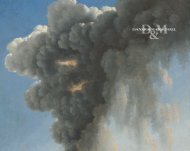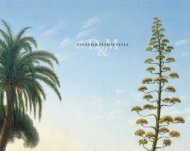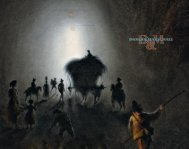Catalogue 2010 - daxer & marschall
Catalogue 2010 - daxer & marschall
Catalogue 2010 - daxer & marschall
Create successful ePaper yourself
Turn your PDF publications into a flip-book with our unique Google optimized e-Paper software.
ANSELM FEuERBACH<br />
Narrow Path in the Campagna Romana<br />
Anselm Feuerbach<br />
(Speyer 1829 - 1880 Venice)<br />
Narrow Path in the Campagna<br />
Romana, c. 1860-2<br />
Oil on canvas<br />
Signed with the initials at the lower<br />
left AF (in ligature)<br />
47 x 36 cm<br />
Provenance:<br />
Rudolf Probst, Das Kunsthaus,<br />
Mannheim, 1942<br />
Private collection, Switzerland<br />
Literature:<br />
Weltkunst, 16/37-8, 12 September<br />
1942, repr. p. 4 (advertising Rudolf<br />
Probst’s Kunsthaus in Mannheim) 1<br />
Jürgen Ecker, Anselm Feuerbach.<br />
Leben und Werk. Kritischer Katalog<br />
der Gemälde, Ölskizzen und Ölstudien,<br />
catalogue raisonné, Munich 1991,<br />
no. 292<br />
50<br />
This very fine study depicts a steep, narrow path partly overhung by vegetation in a rocky hillside.<br />
Feuerbach would have seen many similar paths hewn into the rock on his excursions into the<br />
countryside of the Campagna Romana. The painting focuses on the contrast between the areas of<br />
shade with their soft, flowing contours and clearly defined, light-infused patches of stone, earth and<br />
vegetation.<br />
The Feuerbach expert Jürgen Ecker suggests that the study is dateable to the late 1850s<br />
on the basis of the characteristics of the monogram. Similar autographic traits are to be found in<br />
other works of the period. 2 However he points out that a date of execution in the early 1860s is not<br />
implausible on stylistic grounds.<br />
The fluid, very free manner of execution with its focus on light and atmospheric effect is<br />
a style Feuerbach adopted during his sojourn in Paris between 1851 and 1854. 3 Overwhelmed by<br />
the collections in the Louvre, he sought inspiration in the work of the Old Masters. Before long,<br />
he turned to the work of contemporary French artists – Eugène Delacroix, Gustave Courbet and<br />
the painters of the Barbizon School. Not only was the experience of their work to have a formative<br />
influence on his painting but his contacts with the painter Thomas Couture (1815-79), whose studio<br />
he shared for a time, were of key importance in his later career.<br />
His indebtedness to the art of Couture is apparent in the new freedom and fluidity of his<br />
brushwork. 4 Couture’s influence is also apparent in the compositional breadth and monumentality<br />
of Feuerbach’s handling of the subject, combined with use of soft tonal gradations and subtle<br />
colouristic refinement. All these elements are clearly evident in the present study. Feuerbach wrote<br />
in a letter to his mother: Couture’s figures possess the sculptural nobility and beauty of the antique. My eyes are<br />
being opened daily to what dear Father [Feuerbach’s father was an archaeology professor] always wanted<br />
despite his sufferings, and even though I was late in realizing it, the knowledge of it will be with me all my life. 5<br />
We are grateful to Dr. Jürgen Ecker for his assistance in researching the provenance and dating of<br />
this study.<br />
1. See Anja Walter-Ris, Die Geschichte der Galerie Nierendorf, Diss., Fu Berlin 2003, note 31: [Dr. Herbert Tannenbaum] … founded a gallery<br />
named ‘Das Kunsthaus’ in Mannheim in 1920. From 1933 onwards, he found himself increasingly subjected to anti-Semitic attacks. In November<br />
1936 he sold the gallery to a colleague, Rudolf Probst (1890-1968). A victim of Nazi repression, Probst had been forced to close his own gallery, Galerie<br />
Neue Kunst Fides, in Dresden in 1934, and was optimistic that he could resume his gallery activities at new premises in Mannheim. This he managed<br />
to do by pursuing a ‘less extreme’ programme – until the Kunsthaus was destroyed by bombing in 1943. See also: K. L. Hofmann, C. Präger and<br />
K. von Welck (eds.), Für die Kunst! Herbert Tannenbaum und sein Kunsthaus. Ein Galerist – seine Künstler, seine Kunden, sein Konzept, exhib.<br />
cat., Mannheim, Reiß-Museum Mannheim, 1994.<br />
2. Characteristic traits of the ‘AF’ ligature on other Feuerbach works of the period are the rather pronounced downstroke on the ‘F’ and<br />
the left slant of the ligature.<br />
3. Feuerbach interrupted his visit several times. He was in Paris from May 1851 to the summer of 1852, from November 1852 to May 1853<br />
and from October 1853 to April 1854.<br />
4. Feuerbach would have witnessed Couture, and possibly Courbet, using a painting knife or a palette knife.<br />
5. Guido Joseph Kern and Hermann uhde-Bernays (eds.), Anselm Feuerbachs Briefe an seine Mutter, I, Berlin 1911, p. 299.






